Scoliosis is a disorder of the spine. The following article deals with the causes, symptoms and treatment options for the same.
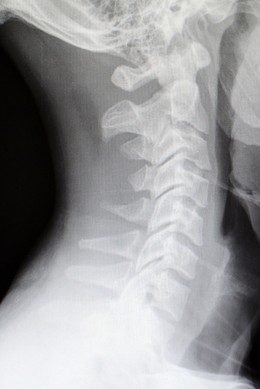
Scoliosis is not a disease. It is a condition in which there is an abnormal sideways curvature in the spine. Any part of the spine can bend but the most common parts that get affected are the chest (upper back) area or the lower part of the back. The spine can curve to the right, left or sometimes both the sides. The curve can occur in varying degrees, which determines the severity of the condition. When the curve occurs in the lumbar (lower) region of the spine, it does not affect the posture. However, the curve in the thoracic (upper) region causes a twist in the rib cage, which makes the misalignment of the body more visible. If the curve gets worse, the spine may rotate or even twist. In an extreme case of scoliosis, there may be severe back pain and other vital organs like the lungs, heart may get damaged.
When scoliosis occurs, the curves of the spine can be classified on the basis of their shape in the following ways:
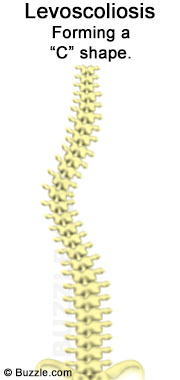
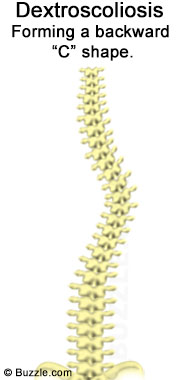
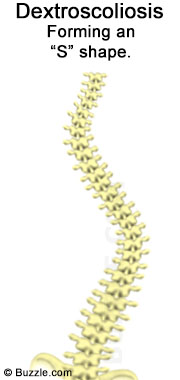
- Levoscoliosis: In this type the curvature of the spine is towards left giving it the "C" shape. This type of scoliosis is considered to be the most dangerous as the heart is located in that area and may be in danger. The degree of the curve determines the severity of the disorder.
- Dextroscoliosis: In this type the curvature is to the opposite side of levoscoliosis i.e., towards the right and looks like a backward "C". The curve is also known as lordotic curve.
- Dextroscoliosis (forming an "S" shape): In this type of scoliosis, there are two curves in the spinal column, which result in an "S" shaped spine.
The curves shown in the above illustrations can further be classified according to their location and can be defined as follows:
- Thoracic Curve: It occurs in the middle (thoracic) portion of the spine.
- Lumbar Curve: It occurs in the lower (lumbar) portion of the spine.
- Thoracolumbar Curve: The curvature spans over almost all vertebrae in the thoracic column and also in the lumbar column on one side.
- Double Major Curve: In this type the curves occur on both right and the left side.
Types and their Causes
Any of the curves mentioned above may occur in the following types of scoliosis:
Congenital Scoliosis
It occurs before birth while the fetus is growing in the womb. A part of one or more vertebrae, during the formation of the spine, may not form properly leading to a curved spine. Also, the spine initially forms as a single column of tissue and then separates into various bony segments called vertebrae. However, when the separation is incomplete, two or more vertebrae are fused together which stops the spinal growth from one side resulting into a spinal curve. It is a very rare condition. However, if it occurs then needs to be corrected surgically.
Neuromuscular Scoliosis
It is caused by poor muscle control or muscle weakness and illnesses that affect the nerves. A disorder called cerebral palsy may cause neuromuscular scoliosis. It is a condition wherein there is a brain damage that occurs at birth or a while later. Another illness that may result in neuromuscular scoliosis is muscular dystrophy, a genetic disorder that weakens the muscles. Certain other disorders that may cause neuromuscular scoliosis are spina bifida and polio.
Idiopathic Scoliosis
When scoliosis develops in a previously straight spine without an identifiable cause, it is known as idiopathic scoliosis. It is the most common type of scoliosis usually observed in girls. It is more common in adolescents, and gets worse as they grow. The curve may become more pronounced in the later stages of life.
Degenerative Scoliosis
It usually occurs in women above 40 years of age. Because of the deterioration of bones, the spine loses ability to maintain its normal shape and begins to sag. This results into a scoliotic curve in the spine. Degenerative scoliosis may also result from injuries or illnesses like a major back injury, osteoporosis or a traumatic bone collapse. The parts of the spine that are involved in the damage are vertebrae that support the spine and the neck, tendons that connect the bones in the spine to the muscles, discs that provide a cushion to the vertebrae and the ligaments that hold the discs and vertebrae together.
Symptoms
The symptoms of scoliosis may differ from one individual to another depending upon the type, cause and severity of the disorder. However, there are some common symptoms, which include:
- The head tilted and not in line with rest of the body
- The hip appearing lower than the usual position and tilted to one side
- One shoulder blade appearing higher than the other
- Shoulders uneven in height
- An uneven neckline
- The breasts developing in unequal size, in young girls
- On bending forward, one side of the upper back appearing higher than the other
A person with scoliosis is likely to experience backache or lower-back pain. After a long period of sitting or standing, they are also likely to feel weakness in the spine. The pain usually gets worse, if irritation results. Severe scoliosis, where the curve in the spine is greater than 100 degrees, can cause breathing problems.
Diagnosis
In order to diagnose scoliosis, a medical practitioner will first carry out a physical examination. Part of it is a forward bending test, that will enable the doctor to define the curve. However, this is not sufficient for the degree of the curve to be clearly defined, so an x-ray, taken from the front and side of the spine is usually recommended. The doctor will also perform a neurological exam to look for any changes in strength, sensation, or reflexes. Additionally, scoliometer measurements (a device for measuring the curvature of the spine) are usually taken, and if required, an MRI scan may be carried out.
Treatment
The course of treatment for scoliosis depends on a number of factors:
- Type and cause of the disorder
- Degree, pattern, size and location of the curve
- Age of the person
In mild cases of scoliosis a treatment is not required. Repeated examinations every 4 to 6 months are done to determine the progress of the curve. If the curve continues to grow, the doctor may recommend either of the following treatment options.
Bracing
If idiopathic scoliosis is more than 25 to 30 degrees, in a growing child, a brace is recommended to slow the progression of the curve. Braces are of several types and each of them appears and functions differently. A brace does the act of putting pressure on the spine to straighten it and is adjusted as the person grows. However, it cannot be utilized for cases of congenital or neuromuscular scoliosis. The most common types of braces have been illustrated below for better understanding.
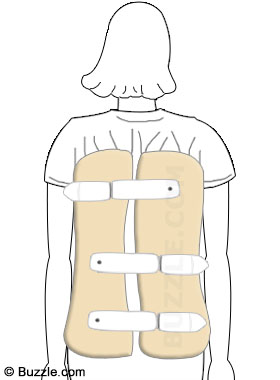
Boston Brace
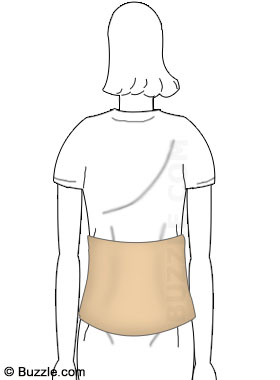
Wilmington Brace
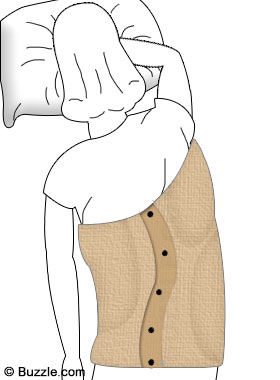
Charleston Brace
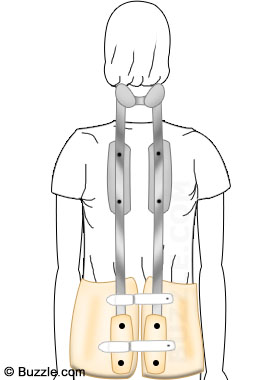
Milwaukee Brace
Adolescents who develop scoliosis, struggle with issues of self-confidence and self image which emanate from having to wear a brace. Emotional support and understanding is what teenagers need during this time.
Surgery
A surgical treatment for scoliosis is recommended only when the spinal curve is above 50 degrees and the bracing technique fails to correct the problem. If the curve is between 40 to 50 degrees the doctors have to consider all the surrounding factors before recommending a surgery. The main objective behind a surgery is to correct the spinal curve and prevent it from getting worse. However, the result would not be a perfectly straight spine but will definitely prevent it from worsening.
➡ There are various techniques used in this type of treatment, one of them being the
spinal fusion. In this method, the spinal curve is stabilized and reduced in size and prevented from growing. Metal plates, screws and rods are attached to the vertebrae to fuse them together permanently and block the movement between them. When the vertebrae start healing they become one solid unit instead of separate columns.
➡
Spinal instrumentation without fusion is another method of treating scoliosis. This method is used in case of young children because the spine is still growing and fusion may stop its growth. The metal rods are attached to the vertebrae in such a way that they stabilize the spinal curve but do not fuse the vertebrae together, which allows the spine to complete its growth. However, the drawback of this surgical procedure is that the child has to wear a full-time brace after the surgery.
Disclaimer: This Buzzle article is for informative purposes only and does not, in any way, intend to replace the advice of a medical expert.


 Scoliosis is not a disease. It is a condition in which there is an abnormal sideways curvature in the spine. Any part of the spine can bend but the most common parts that get affected are the chest (upper back) area or the lower part of the back. The spine can curve to the right, left or sometimes both the sides. The curve can occur in varying degrees, which determines the severity of the condition. When the curve occurs in the lumbar (lower) region of the spine, it does not affect the posture. However, the curve in the thoracic (upper) region causes a twist in the rib cage, which makes the misalignment of the body more visible. If the curve gets worse, the spine may rotate or even twist. In an extreme case of scoliosis, there may be severe back pain and other vital organs like the lungs, heart may get damaged.
Scoliosis is not a disease. It is a condition in which there is an abnormal sideways curvature in the spine. Any part of the spine can bend but the most common parts that get affected are the chest (upper back) area or the lower part of the back. The spine can curve to the right, left or sometimes both the sides. The curve can occur in varying degrees, which determines the severity of the condition. When the curve occurs in the lumbar (lower) region of the spine, it does not affect the posture. However, the curve in the thoracic (upper) region causes a twist in the rib cage, which makes the misalignment of the body more visible. If the curve gets worse, the spine may rotate or even twist. In an extreme case of scoliosis, there may be severe back pain and other vital organs like the lungs, heart may get damaged.





